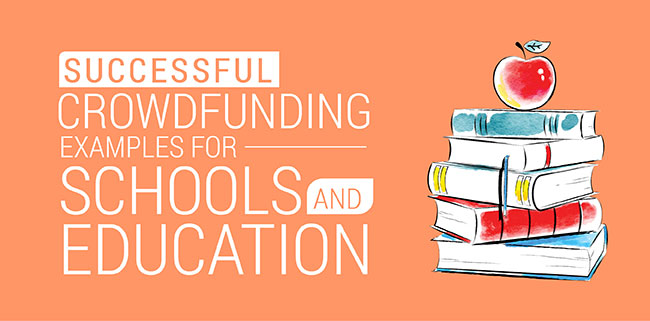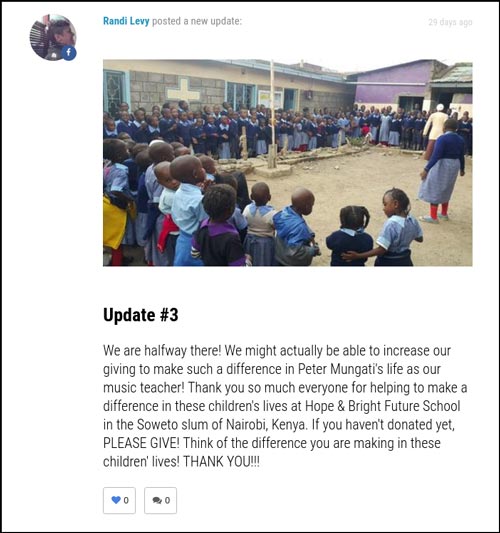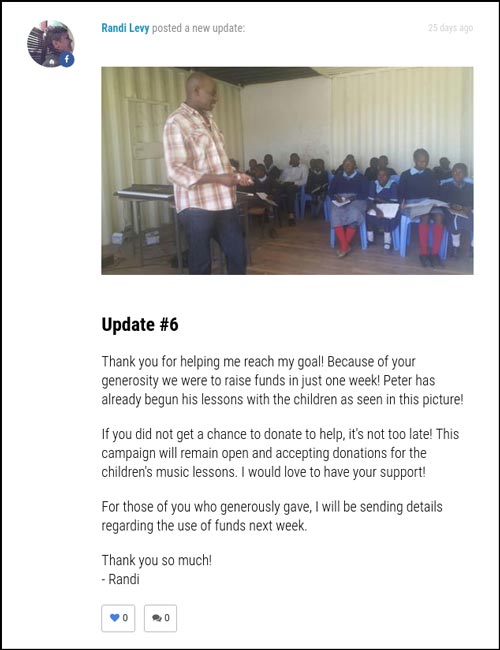Successful Crowdfunding Examples for Schools and Education
Crowdfunding can be a great asset to schools or educational organizations. Since crowdfunding gives you a platform to share your story, you have the opportunity to spread the word about your cause as you raise funds and continue to educate students.
Fundraising online may be new territory for your school, but with a few best practices, you can create an effective campaign to help you reach your goals.
To get an idea of what you can do with crowdfunding campaigns, we’ll look at an example that managed to go beyond their fundraising goal.
You can use the same techniques that the Music Teacher for Nairobi crowdfunding campaign used.
We’ll cover three components that contributed to this campaign’s success:
Keep reading to learn how you can create a crowdfunding campaign using similar best practices!
1. crowdfunding updates
While building your campaign page and writing your description are all elements that will contribute to your campaigns outcome, you should always continue to update and improve your campaign to raise even more funds for your cause.
You can achieve this by posting updates to your fundraising page to let donors know about your campaign’s progress and thank donors for supporting your cause.
Updates can help to keep your campaign’s momentum going and encourage people to donate after the initial excitement dies down.
Crowdfunding update examples:
The creator of the Music Teacher for Nairobi campaign posted updates on a regular basis to keep supporters informed about the campaign and its success.
Let’s look at an example:
In the example, the creator mentions that they are at the halfway mark. The creator also includes an image of the students with some of them playing with the instruments. The visual helps connect donors to the cause.
The update is very clear and straightforward about how the funds will be used, making it easy for donors to read even if they have busy schedules.
Since the students already have instruments, they just need a music instructor to help teach them how to play. Plus, the campaign creator uses the update to show potential donors the impact their contributions can make by showing donors how learning an instrument can lift a child’s spirit.
Here is another update that the campaign creator posted after the fundraiser reached its goal:
This post achieves a lot of things:
- First, the campaign creator thanks donors for helping them reach their goal and focuses on the donors’ impact.
- Secondly, the update has a picture that shows the students learning music from their new teacher. This allows donors to see how the funds are being used. Since the campaign is still running it might encourage even more people to support the cause.
- Finally, the creator asks for more donations so that they can maintain the students’ music lessons. The campaign creator continues to ask for donations even though the goal is met, letting supporters know that the campaign is still actively fundraising and has a purpose for the extra funds.
These updates along with several more helped this campaign reach its goals and receive $600 over their fundraising goal.
Best practices for crowdfunding updates:
Now that you see why fundraising updates are so important, you can start using similar strategies to create your own crowdfunding updates.
Use these best practices to get started:
- Include images in your updates. Images can do more than just grab your donors’ attention—they can also help donors visualize the cause they’re supporting. For instance, if you’re raising funds for an after-school program, then taking pictures of students at your program will help donors understand why your campaign is important.
- Thank your donors in every update. No matter how far along your campaign is, it’s vital to thank your donors so that they know you appreciate their contributions. When donors see that you appreciate them, they’ll be more likely to contribute to your cause later on.
- Be clear and direct with donors. One of the simplest ways to post updates is by letting donors know how the funds will be used. You can help donors understand what their contributions will go toward and how that support will impact the people affected.
Crowdfunding updates are rarely used, but they have the potential to boost your campaign’s success and get you to the finish line.
2. Meaningful images and videos
If you’ve looked at crowdfunding campaigns, you may notice a correlation between the number of visuals and the amount of money that was raised.
It’s no surprise that images and videos help increase the amount you raise. Not only are these features engaging, but they also help convey your mission in a way that can’t be easily shown through words.
Schools and education-based organizations should use images and videos to depict their students’ stories. Donors will connect with the children and seek to contribute in any way they can.
Crowdfunding image and video examples:
When you land on the Music Teacher for Nairobi campaign, here is what you’ll see:
The first thing that you see is a video that shows the students singing and enjoying their new instruments. There are also two other videos that show how happy the students are with their instruments.
Not only does this show donors what impact their donations will have, but it also gives donors a little taste of what the cause supports. Donors will connect with the students and want to contribute.
Here is an example of how the campaign incorporated video into your crowdfunding campaign:
In the video, students are playing and—more importantly—enjoying their musical instruments. Donors can see how much learning music means to the children. Seeing their joy evokes donors’ emotions and gives them a reason to support the Music Teacher for Nairobi campaign.
By giving donors a taste of your school’s project or highlighting the students, you’re helping them develop a connection to your cause and the affected students.
The campaign includes both images and videos to keep potential donors engaged and give them more context for the fundraiser.
Not only does the campaign creator highlight the students, but they also focus on the music instructor, who will use the funds to support himself while he is teaching the students. That way, donors get the opportunity to learn more about the person who’s receiving the funds.
Best practices for images and videos:
Videos work especially well for schools and other education-related causes because it gives donors an opportunity to put themselves in the students’ shoes and gain a better understanding of why the project is so important. Since many donors won’t be familiar with your project, visuals are captivating, shareable tools that can convey your message better than words.
If you want to include visuals on your crowdfunding page, follow these best practices:
- Focus on the students and the donors. Instead of highlighting the achievements of your school or educational program, your images and videos should showcase the students and how the funds will affect their education. Ultimately, your donors will be more concerned about how the money will benefit the students, rather than your past accomplishments.
- Post both images and videos. While images can say a thousand words, videos can give donors the complete experience. By using both visuals, donors can experience your project or cause from different angles.
- Brand your visuals. If you plan to use your images and videos for other parts of your crowdfunding campaign (i.e. on social media), you should brand your images and videos so that donors know where they came from. You’ll reach more interested supporters when you make it easy to find your campaign.
Visuals are crucial to your campaign’s success. But you might be hesitant to post images or record a video because you’re not an expert in photography or filming. Luckily, you don’t have to be a professional!
By learning a few simple strategies and using equipment you already have you can create spectacular looking visuals for your campaign.
3. Effective social sharing
If you’re fundraising for a school project or education-related cause, it’s essential that you share your campaign on social media. While you can reach students, faculty, and parents through word-of-mouth, you’ll need to reach even more supporters if you want to meet your goal.
Social media is a poplar platform to share your crowdfunding campaign because most people access Facebook and Twitter daily. Posting on social media puts your campaign in front of those who will care about your cause the most.
Social sharing example:
The campaign creator of the Music Teacher for Nairobi crowdfunding page took advantage of Facebook, the most used platform, to share the fundraiser.
Look at this Facebook example:
This post is a strong example of how you should create your own Facebook posts. Here’s why:
- The copy is short and concise. The post doesn’t spend too many words describing the cause (donors can always learn more on the crowdfunding page). Instead, the campaign creator writes a simple sentence, asking people to share the cause with their networks.
- The post includes a hashtag. The hashtag helps potential donors find the post. Plus, by using #fundly, donors know exactly where to find the crowdfunding page.
- There is a link to the crowdfunding page. Linking to the page allows donors easy access to your donation page. The link also serves another purpose: when URLs are placed in Facebook posts, images from your crowdfunding page will show up in the message, making your post more noticeable.
Let’s look at another example:
In the example, the campaign creator highlights two contributors. By publicly showing gratitude, the author shows that everyone’s support is appreciated. Plus, thanking supporters on social media may attract potential donors to your cause.
The campaign creator doesn’t just showcase the supporters but also tags them in the post so that they can see the message and potentially share it with their networks.
Social sharing best practices:
As demonstrated in the examples above, social sharing is important for schools and educational causes.
But, how can you apply the techniques that the Music Teacher for Nairobi used on your own campaign?
The following tips can help you create your own posts on social media:
- Use hashtags or create your own. You’ll want to keep track of the conversations surrounding your school’s campaign. Creating a hashtag and encouraging donors to use it will allow you to see what people are saying. Plus, including them in your own posts makes your crowdfunding campaign easier to find.
- Write copy that hooks your donors in. It’s important to capture your donors’ attention especially since you’ll be competing with every other post on their newsfeeds. A concise, punchy message is quick to read and will leave your donors wanting more information.
- Post more than just direct solicitations. While asking for donations is important, it’s not the only way to gain attention on social media. You can also share details about your campaign, highlight contributors, and engage in the conversation around your fundraiser.
For more tips on how to create social media posts, check out this article on social media templates.
Crowdfunding is a tool schools and educational causes can use to raise money. Now that you’ve seen the techniques and strategies used by the Music Teacher for Nairobi campaign, you can start your own online fundraiser.
Want more tips to improve your crowdfunding campaign? Check out these additional resources:
- Maintain Momentum. Most crowdfunding campaigns see a ton of interest in the first few weeks, but if you want to maintain that attention, you’ll need to stay consistent. Use these tips to help you.
- Promote Your Campaign on Facebook. With over a billion users, Facebook is the perfect social media platform to spread the word about your crowdfunding page. Learn how to market on Facebook so that you can reach the most potential donors as possible.
- Crowdfunding Website. Now that you’ve got the strategies to run a crowdfunding campaign, you need to find the website for your school’s needs. Check out this list of 15 top crowdfunding websites.










